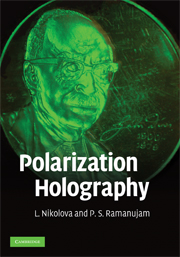Book contents
- Frontmatter
- Contents
- Preface
- List of symbols and abbreviations
- 1 Light polarization
- 2 Light propagation through polarizing systems
- 3 Theory of polarization holography
- 4 Azobenzene and azobenzene-containing polymers
- 5 Other photoanisotropic materials
- 6 Applications of polarization holography
- 7 Conclusions and future prospects
- Index
- Plate section
3 - Theory of polarization holography
Published online by Cambridge University Press: 07 August 2009
- Frontmatter
- Contents
- Preface
- List of symbols and abbreviations
- 1 Light polarization
- 2 Light propagation through polarizing systems
- 3 Theory of polarization holography
- 4 Azobenzene and azobenzene-containing polymers
- 5 Other photoanisotropic materials
- 6 Applications of polarization holography
- 7 Conclusions and future prospects
- Index
- Plate section
Summary
In this chapter, we shall examine first the principles of interference and holography and extend them to the concept of polarization holography. We shall study the specific character of the periodic anisotropic structures obtained by the holographic method, which we call polarization holograms. We shall show how their efficiency and their polarization properties depend on the choice of recording geometry and on the photoinduced anisotropy in the materials. Since the formation of linear anisotropy is more common and more pronounced in photoanisotropic materials known at the moment, we first consider polarization holography in materials with linear anisotropy only. Then we extend the consideration to materials with both linear and circular anisotropy. The appearance of relief gratings on the surface of polarization holograms is also taken into account.
Plane-wave interference and holography
The holographic method was first proposed by Denis Gabor in 1948 [1] as a method for the reconstruction of wavefronts. Gabor proposed a two-stage process. The first stage is a two-dimensional photographic storage of the intensity distribution in the interference pattern of the signal wave (S) with a reference wave (R). At the second stage the reference wave illuminates the obtained photograph and reconstructs both the amplitude and the phase of the signal wavefront. The method was called “holography”, that is, “whole writing”. Later it was shown by Denisyuk [2] that, if three-dimensional (volume) materials are used to fix the interference field, the wavelength of the signal wave could also be restored.
Information
- Type
- Chapter
- Information
- Polarization Holography , pp. 24 - 87Publisher: Cambridge University PressPrint publication year: 2009
Accessibility standard: Unknown
Why this information is here
This section outlines the accessibility features of this content - including support for screen readers, full keyboard navigation and high-contrast display options. This may not be relevant for you.Accessibility Information
- 1
- Cited by
